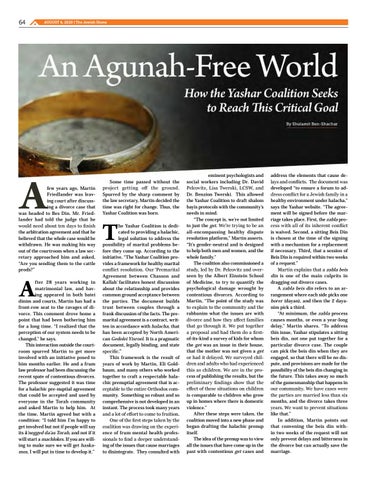64 8
AUGUST 6, 2020 | The Jewish Home OCTOBER 29, 2015 | The Jewish Home
A
few years ago, Martin Friedlander was leaving court after discussing a divorce case that was headed to Bes Din. Mr. Friedlander had told the judge that he would need about ten days to finish the arbitration agreement and that he believed that the whole case would be withdrawn. He was making his way out of the courtroom when a law secretary approached him and asked, “Are you sending them to the cattle prods?”
A
fter 28 years working in matrimonial law, and having appeared in both batei dinim and courts, Martin has had a front-row seat to the ravages of divorce. This comment drove home a point that had been bothering him for a long time. “I realized that the perception of our system needs to be changed,” he says. This interaction outside the courtroom spurred Martin to get more involved with an initiative posed to him months earlier. He and a frum law professor had been discussing the recent spate of contentious divorces. The professor suggested it was time for a halachic pre-nuptial agreement that could be accepted and used by everyone in the Torah community and asked Martin to help him. At the time, Martin agreed but with a condition: “I told him I’m happy to get involved but not if people will say its k’negged da’as Torah, and not if it will start a machlokes. If you are willing to make sure we will get haskamos, I will put in time to develop it.”
Some time passed without the project getting off the ground. Spurred by the sharp comment by the law secretary, Martin decided the time was right for change. Thus, the Yashar Coalition was born.
T
he Yashar Coalition is dedicated to providing a halachic, legal solution to address the possibility of marital problems before they come up. According to the initiative, “The Yashar Coalition provides a framework for healthy marital conflict resolution. Our ‘Premarital Agreement between Chasson and Kallah’ facilitates honest discussion about the relationship and provides common ground acceptance between the parties. The document builds trust between couples through a frank discussion of the facts. The premarital agreement is a contract, written in accordance with halacha, that has been accepted by North American Gedolei Yisroel. It is a pragmatic document, legally binding, and state specific.” This framework is the result of years of work by Martin, Eli Goldbaum, and many others who worked together to craft a respectable halachic prenuptial agreement that is acceptable to the entire Orthodox community. Something so robust and so comprehensive is not developed in an instant. The process took many years and a lot of effort to come to fruition. One of the first steps taken by the coalition was drawing on the experience of frum mental health professionals to find a deeper understanding of the issues that cause marriages to disintegrate. They consulted with
eminent psychologists and social workers including Dr. David Pelcovitz, Lisa Twerski, LCSW, and Dr. Benzion Twerski. This allowed the Yashar Coalition to draft shalom bayis protocols with the community’s needs in mind. “The concept is, we’re not limited to just the get. We’re trying to be an all-encompassing healthy dispute resolution platform,” Martin asserts. “It’s gender-neutral and is designed to help both men and women, and the whole family.” The coalition also commissioned a study, led by Dr. Pelcovitz and overseen by the Albert Einstein School of Medicine, to try to quantify the psychological damage wrought by contentious divorces. According to Martin, “The point of the study was to explain to the community and the rabbanim what the issues are with divorce and how they affect families that go through it. We put together a proposal and had them do a firstof-its-kind a survey of kids for whom the get was an issue in their house, that the mother was not given a get or had it delayed. We surveyed children and adults who had experienced this as children. We are in the process of publishing the results, but the preliminary findings show that the effect of these situations on children is comparable to children who grow up in homes where there is domestic violence.” After these steps were taken, the coalition moved into a new phase and began drafting the halachic prenup itself. The idea of the prenup was to view all the issues that have come up in the past with contentious get cases and
address the elements that cause delays and conflicts. The document was developed “to ensure a forum to address conflict for a Jewish family in a healthy environment under halacha,” says the Yashar website. “The agreement will be signed before the marriage takes place. First, the zabla process with all of its inherent conflict is waived. Second, a sitting Beis Din is chosen at the time of the signing with a mechanism for a replacement if necessary. Third, that a session of Beis Din is required within two weeks of a request.” Martin explains that a zabla beis din is one of the main culprits in dragging out divorce cases. A zabla beis din refers to an arrangement where each side picks one borer (dayan), and then the 2 dayanim pick a third. “At minimum, the zabla process causes months, or even a year-long delay,” Martin shares. “To address this issue, Yashar stipulates a sitting beis din, not one put together for a particular divorce case. The couple can pick the beis din when they are engaged, so that there will be no dispute, and provisions are made for the possibility of the beis din changing in the future. This takes away so much of the gamesmanship that happens in our community. We have cases were the parties are married less than six months, and the divorce takes three years. We want to prevent situations like that.” In addition, Martin points out that convening the beis din within two weeks of the request will not only prevent delays and bitterness in the divorce but can actually save the marriage.


















